Embry-Riddle University: Exercise vs. Medication for Focus Report
VerifiedAdded on 2023/05/28
|18
|3586
|59
Report
AI Summary
This report examines the impact of physical exercise as a potential alternative or complementary treatment for Attention Deficit Hyperactivity Disorder (ADHD). The study investigates whether exercise can improve focus and attention, comparing its effects to those of prescription medication. The report includes an executive summary, table of contents, and an introduction to ADHD, outlining its symptoms and the common use of stimulant medications. It explores the methodology, including research philosophy (positivism), approach (deductive), and design (descriptive), along with data collection methods using questionnaires. The report presents two hypotheses, analyzing data using t-tests and correlations to determine the relationship between physical activity and focus. Variables like independent variable as physical activity and dependent variable as prescription medicine are considered. The findings suggest that physical activity stimulates the brain and can be a helpful intervention along with medication for individuals with ADHD. The report concludes with a discussion of the results and a list of references.
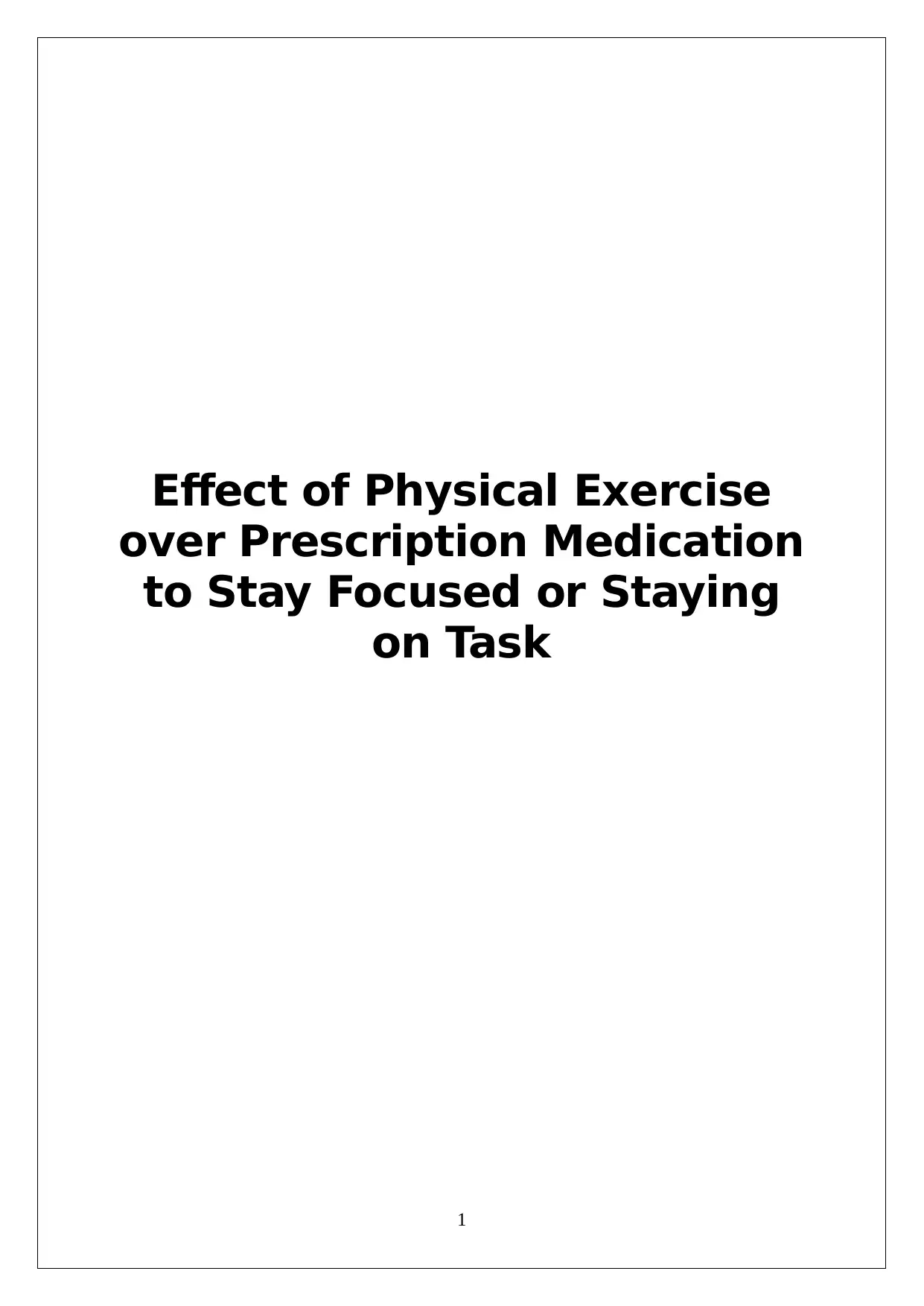
Effect of Physical Exercise
over Prescription Medication
to Stay Focused or Staying
on Task
1
over Prescription Medication
to Stay Focused or Staying
on Task
1
Paraphrase This Document
Need a fresh take? Get an instant paraphrase of this document with our AI Paraphraser
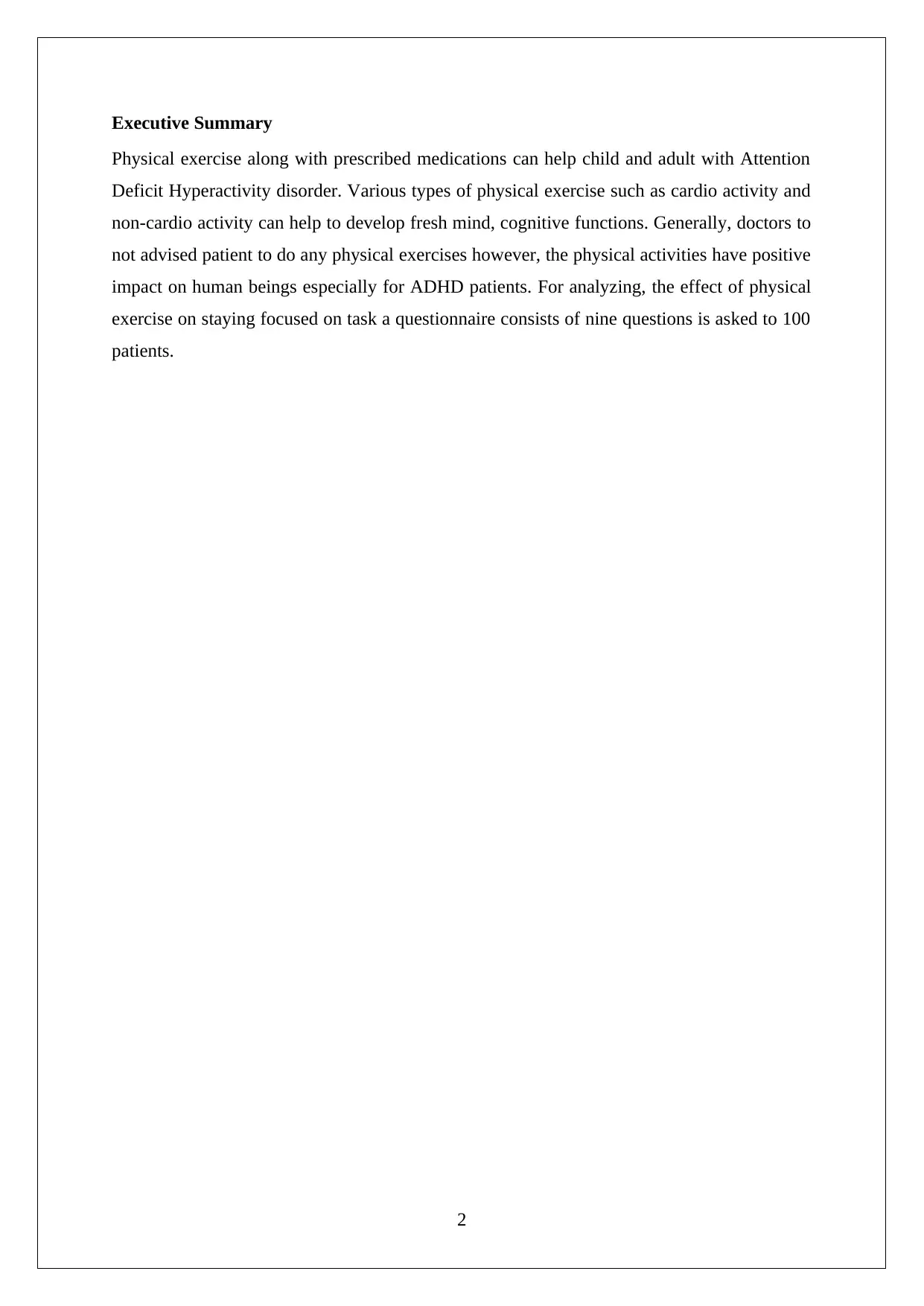
Executive Summary
Physical exercise along with prescribed medications can help child and adult with Attention
Deficit Hyperactivity disorder. Various types of physical exercise such as cardio activity and
non-cardio activity can help to develop fresh mind, cognitive functions. Generally, doctors to
not advised patient to do any physical exercises however, the physical activities have positive
impact on human beings especially for ADHD patients. For analyzing, the effect of physical
exercise on staying focused on task a questionnaire consists of nine questions is asked to 100
patients.
2
Physical exercise along with prescribed medications can help child and adult with Attention
Deficit Hyperactivity disorder. Various types of physical exercise such as cardio activity and
non-cardio activity can help to develop fresh mind, cognitive functions. Generally, doctors to
not advised patient to do any physical exercises however, the physical activities have positive
impact on human beings especially for ADHD patients. For analyzing, the effect of physical
exercise on staying focused on task a questionnaire consists of nine questions is asked to 100
patients.
2
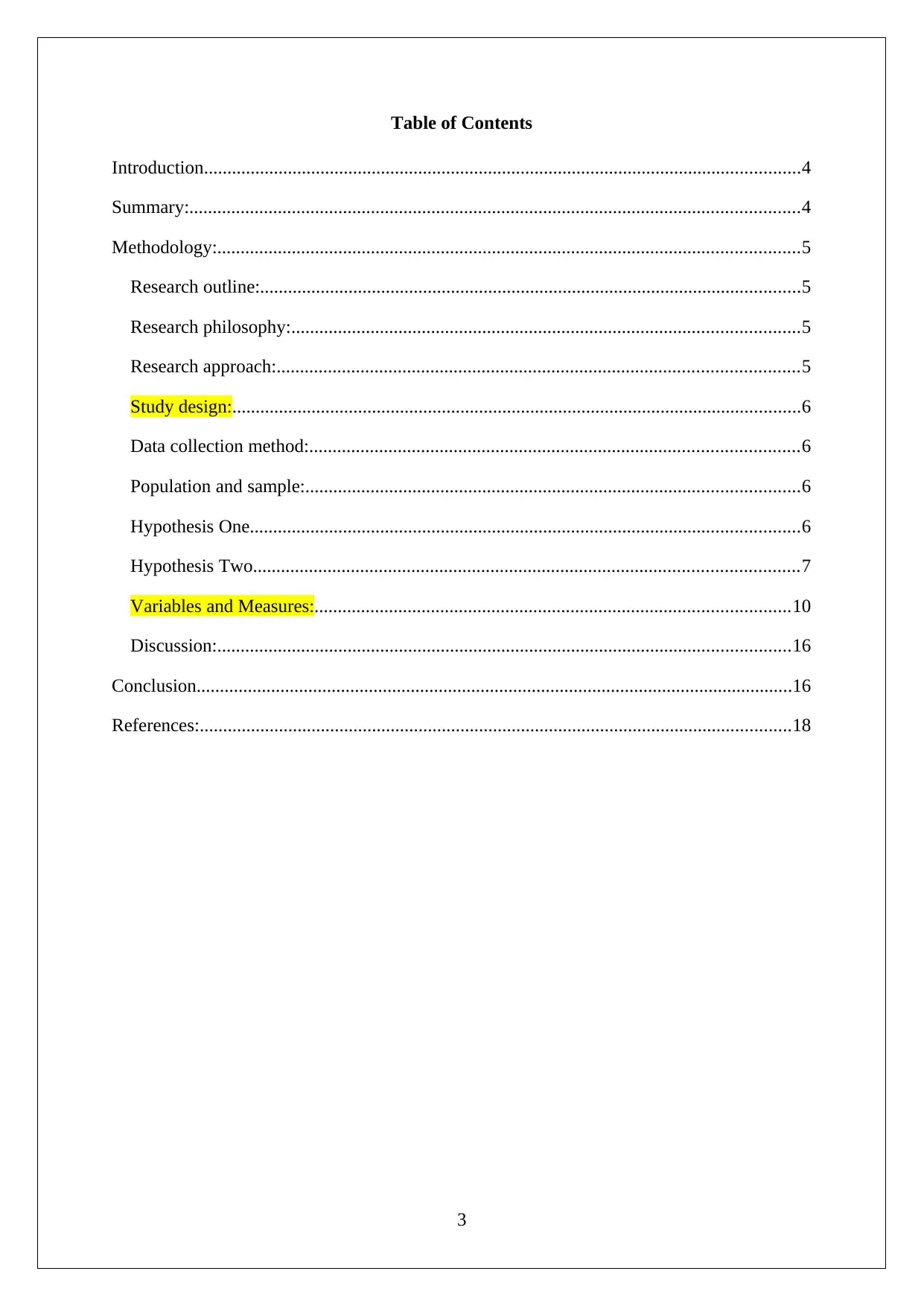
Table of Contents
Introduction................................................................................................................................4
Summary:...................................................................................................................................4
Methodology:.............................................................................................................................5
Research outline:....................................................................................................................5
Research philosophy:.............................................................................................................5
Research approach:................................................................................................................5
Study design:..........................................................................................................................6
Data collection method:.........................................................................................................6
Population and sample:..........................................................................................................6
Hypothesis One......................................................................................................................6
Hypothesis Two.....................................................................................................................7
Variables and Measures:......................................................................................................10
Discussion:...........................................................................................................................16
Conclusion................................................................................................................................16
References:...............................................................................................................................18
3
Introduction................................................................................................................................4
Summary:...................................................................................................................................4
Methodology:.............................................................................................................................5
Research outline:....................................................................................................................5
Research philosophy:.............................................................................................................5
Research approach:................................................................................................................5
Study design:..........................................................................................................................6
Data collection method:.........................................................................................................6
Population and sample:..........................................................................................................6
Hypothesis One......................................................................................................................6
Hypothesis Two.....................................................................................................................7
Variables and Measures:......................................................................................................10
Discussion:...........................................................................................................................16
Conclusion................................................................................................................................16
References:...............................................................................................................................18
3
⊘ This is a preview!⊘
Do you want full access?
Subscribe today to unlock all pages.

Trusted by 1+ million students worldwide
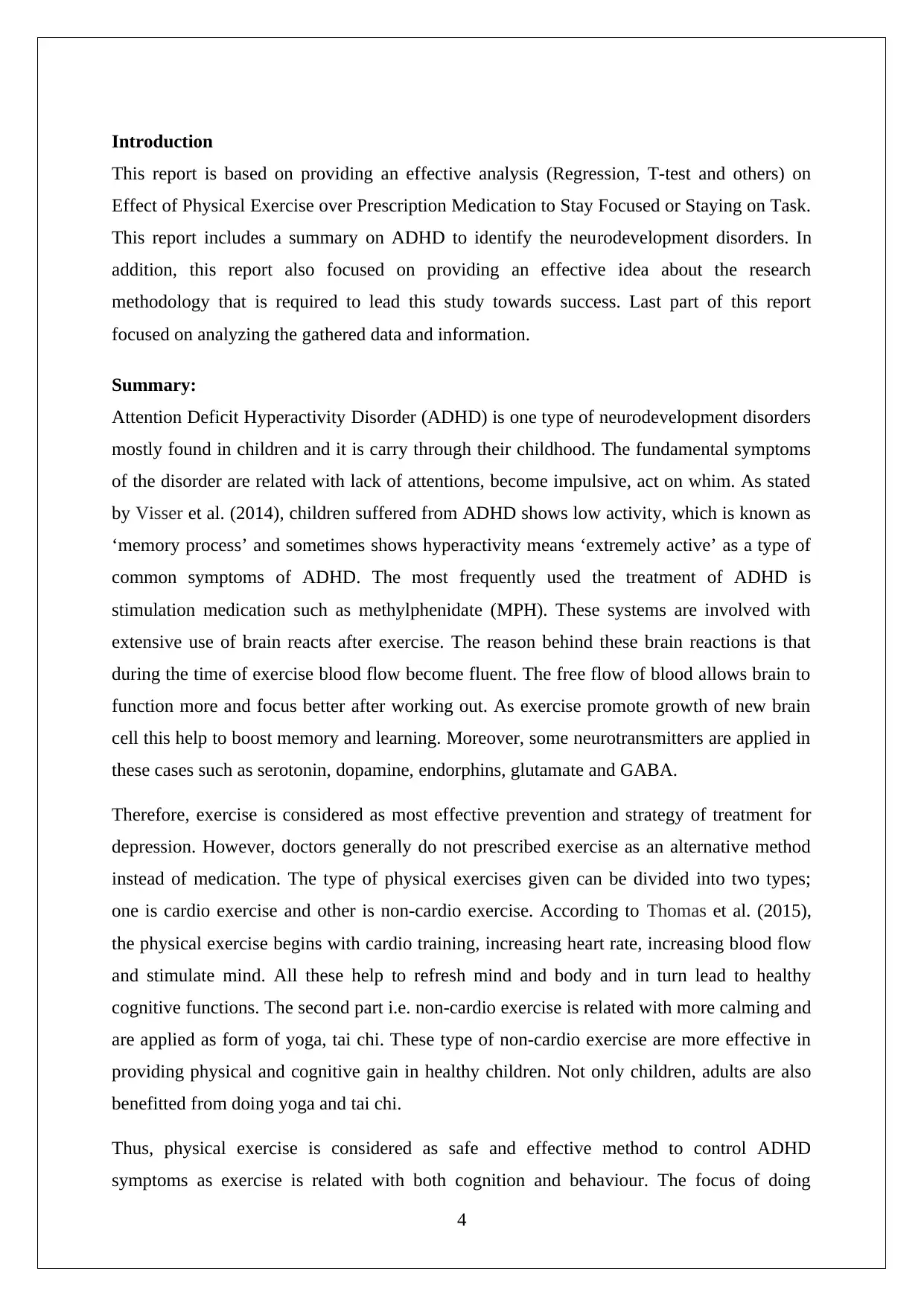
Introduction
This report is based on providing an effective analysis (Regression, T-test and others) on
Effect of Physical Exercise over Prescription Medication to Stay Focused or Staying on Task.
This report includes a summary on ADHD to identify the neurodevelopment disorders. In
addition, this report also focused on providing an effective idea about the research
methodology that is required to lead this study towards success. Last part of this report
focused on analyzing the gathered data and information.
Summary:
Attention Deficit Hyperactivity Disorder (ADHD) is one type of neurodevelopment disorders
mostly found in children and it is carry through their childhood. The fundamental symptoms
of the disorder are related with lack of attentions, become impulsive, act on whim. As stated
by Visser et al. (2014), children suffered from ADHD shows low activity, which is known as
‘memory process’ and sometimes shows hyperactivity means ‘extremely active’ as a type of
common symptoms of ADHD. The most frequently used the treatment of ADHD is
stimulation medication such as methylphenidate (MPH). These systems are involved with
extensive use of brain reacts after exercise. The reason behind these brain reactions is that
during the time of exercise blood flow become fluent. The free flow of blood allows brain to
function more and focus better after working out. As exercise promote growth of new brain
cell this help to boost memory and learning. Moreover, some neurotransmitters are applied in
these cases such as serotonin, dopamine, endorphins, glutamate and GABA.
Therefore, exercise is considered as most effective prevention and strategy of treatment for
depression. However, doctors generally do not prescribed exercise as an alternative method
instead of medication. The type of physical exercises given can be divided into two types;
one is cardio exercise and other is non-cardio exercise. According to Thomas et al. (2015),
the physical exercise begins with cardio training, increasing heart rate, increasing blood flow
and stimulate mind. All these help to refresh mind and body and in turn lead to healthy
cognitive functions. The second part i.e. non-cardio exercise is related with more calming and
are applied as form of yoga, tai chi. These type of non-cardio exercise are more effective in
providing physical and cognitive gain in healthy children. Not only children, adults are also
benefitted from doing yoga and tai chi.
Thus, physical exercise is considered as safe and effective method to control ADHD
symptoms as exercise is related with both cognition and behaviour. The focus of doing
4
This report is based on providing an effective analysis (Regression, T-test and others) on
Effect of Physical Exercise over Prescription Medication to Stay Focused or Staying on Task.
This report includes a summary on ADHD to identify the neurodevelopment disorders. In
addition, this report also focused on providing an effective idea about the research
methodology that is required to lead this study towards success. Last part of this report
focused on analyzing the gathered data and information.
Summary:
Attention Deficit Hyperactivity Disorder (ADHD) is one type of neurodevelopment disorders
mostly found in children and it is carry through their childhood. The fundamental symptoms
of the disorder are related with lack of attentions, become impulsive, act on whim. As stated
by Visser et al. (2014), children suffered from ADHD shows low activity, which is known as
‘memory process’ and sometimes shows hyperactivity means ‘extremely active’ as a type of
common symptoms of ADHD. The most frequently used the treatment of ADHD is
stimulation medication such as methylphenidate (MPH). These systems are involved with
extensive use of brain reacts after exercise. The reason behind these brain reactions is that
during the time of exercise blood flow become fluent. The free flow of blood allows brain to
function more and focus better after working out. As exercise promote growth of new brain
cell this help to boost memory and learning. Moreover, some neurotransmitters are applied in
these cases such as serotonin, dopamine, endorphins, glutamate and GABA.
Therefore, exercise is considered as most effective prevention and strategy of treatment for
depression. However, doctors generally do not prescribed exercise as an alternative method
instead of medication. The type of physical exercises given can be divided into two types;
one is cardio exercise and other is non-cardio exercise. According to Thomas et al. (2015),
the physical exercise begins with cardio training, increasing heart rate, increasing blood flow
and stimulate mind. All these help to refresh mind and body and in turn lead to healthy
cognitive functions. The second part i.e. non-cardio exercise is related with more calming and
are applied as form of yoga, tai chi. These type of non-cardio exercise are more effective in
providing physical and cognitive gain in healthy children. Not only children, adults are also
benefitted from doing yoga and tai chi.
Thus, physical exercise is considered as safe and effective method to control ADHD
symptoms as exercise is related with both cognition and behaviour. The focus of doing
4
Paraphrase This Document
Need a fresh take? Get an instant paraphrase of this document with our AI Paraphraser
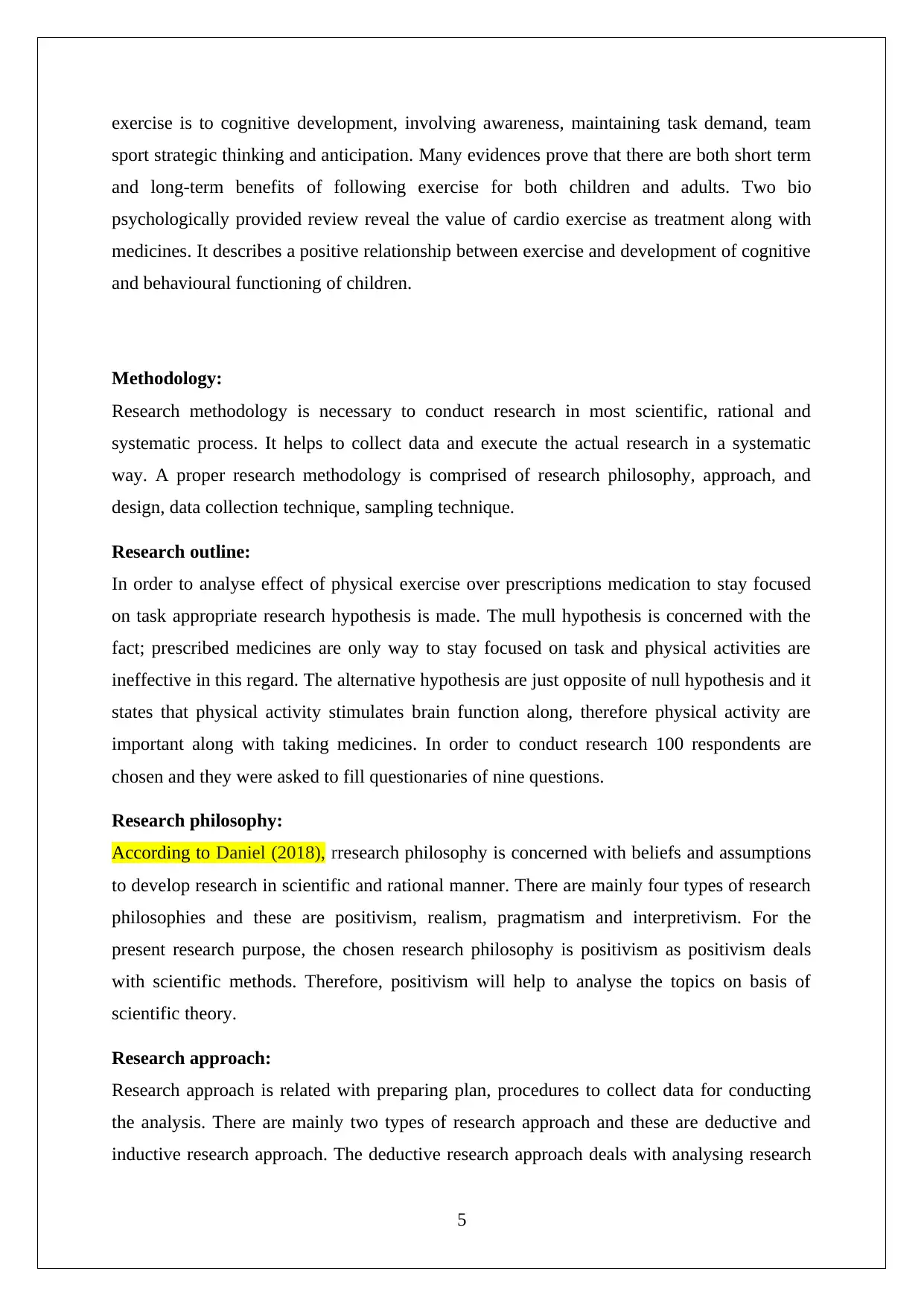
exercise is to cognitive development, involving awareness, maintaining task demand, team
sport strategic thinking and anticipation. Many evidences prove that there are both short term
and long-term benefits of following exercise for both children and adults. Two bio
psychologically provided review reveal the value of cardio exercise as treatment along with
medicines. It describes a positive relationship between exercise and development of cognitive
and behavioural functioning of children.
Methodology:
Research methodology is necessary to conduct research in most scientific, rational and
systematic process. It helps to collect data and execute the actual research in a systematic
way. A proper research methodology is comprised of research philosophy, approach, and
design, data collection technique, sampling technique.
Research outline:
In order to analyse effect of physical exercise over prescriptions medication to stay focused
on task appropriate research hypothesis is made. The mull hypothesis is concerned with the
fact; prescribed medicines are only way to stay focused on task and physical activities are
ineffective in this regard. The alternative hypothesis are just opposite of null hypothesis and it
states that physical activity stimulates brain function along, therefore physical activity are
important along with taking medicines. In order to conduct research 100 respondents are
chosen and they were asked to fill questionaries of nine questions.
Research philosophy:
According to Daniel (2018), rresearch philosophy is concerned with beliefs and assumptions
to develop research in scientific and rational manner. There are mainly four types of research
philosophies and these are positivism, realism, pragmatism and interpretivism. For the
present research purpose, the chosen research philosophy is positivism as positivism deals
with scientific methods. Therefore, positivism will help to analyse the topics on basis of
scientific theory.
Research approach:
Research approach is related with preparing plan, procedures to collect data for conducting
the analysis. There are mainly two types of research approach and these are deductive and
inductive research approach. The deductive research approach deals with analysing research
5
sport strategic thinking and anticipation. Many evidences prove that there are both short term
and long-term benefits of following exercise for both children and adults. Two bio
psychologically provided review reveal the value of cardio exercise as treatment along with
medicines. It describes a positive relationship between exercise and development of cognitive
and behavioural functioning of children.
Methodology:
Research methodology is necessary to conduct research in most scientific, rational and
systematic process. It helps to collect data and execute the actual research in a systematic
way. A proper research methodology is comprised of research philosophy, approach, and
design, data collection technique, sampling technique.
Research outline:
In order to analyse effect of physical exercise over prescriptions medication to stay focused
on task appropriate research hypothesis is made. The mull hypothesis is concerned with the
fact; prescribed medicines are only way to stay focused on task and physical activities are
ineffective in this regard. The alternative hypothesis are just opposite of null hypothesis and it
states that physical activity stimulates brain function along, therefore physical activity are
important along with taking medicines. In order to conduct research 100 respondents are
chosen and they were asked to fill questionaries of nine questions.
Research philosophy:
According to Daniel (2018), rresearch philosophy is concerned with beliefs and assumptions
to develop research in scientific and rational manner. There are mainly four types of research
philosophies and these are positivism, realism, pragmatism and interpretivism. For the
present research purpose, the chosen research philosophy is positivism as positivism deals
with scientific methods. Therefore, positivism will help to analyse the topics on basis of
scientific theory.
Research approach:
Research approach is related with preparing plan, procedures to collect data for conducting
the analysis. There are mainly two types of research approach and these are deductive and
inductive research approach. The deductive research approach deals with analysing research
5
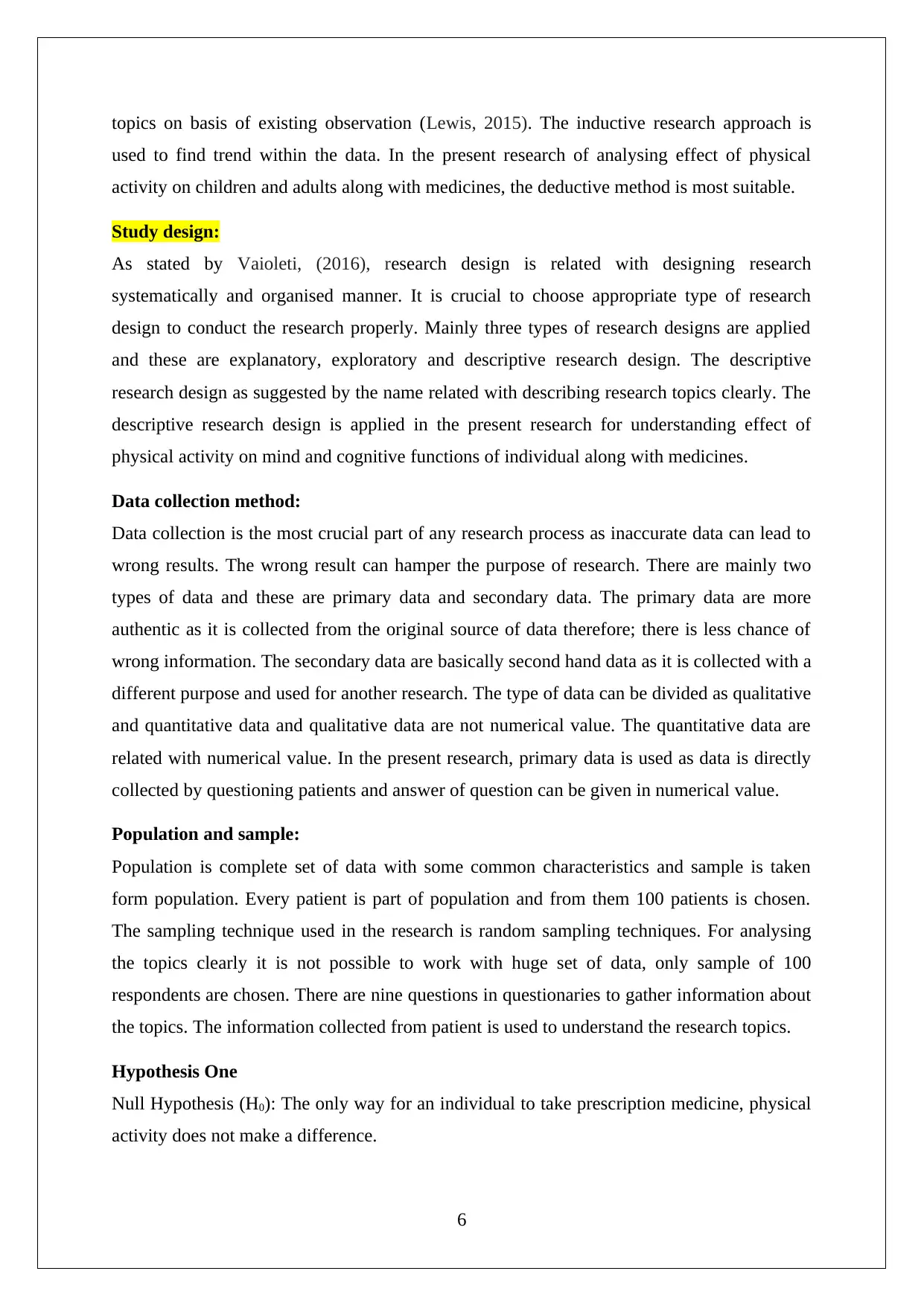
topics on basis of existing observation (Lewis, 2015). The inductive research approach is
used to find trend within the data. In the present research of analysing effect of physical
activity on children and adults along with medicines, the deductive method is most suitable.
Study design:
As stated by Vaioleti, (2016), research design is related with designing research
systematically and organised manner. It is crucial to choose appropriate type of research
design to conduct the research properly. Mainly three types of research designs are applied
and these are explanatory, exploratory and descriptive research design. The descriptive
research design as suggested by the name related with describing research topics clearly. The
descriptive research design is applied in the present research for understanding effect of
physical activity on mind and cognitive functions of individual along with medicines.
Data collection method:
Data collection is the most crucial part of any research process as inaccurate data can lead to
wrong results. The wrong result can hamper the purpose of research. There are mainly two
types of data and these are primary data and secondary data. The primary data are more
authentic as it is collected from the original source of data therefore; there is less chance of
wrong information. The secondary data are basically second hand data as it is collected with a
different purpose and used for another research. The type of data can be divided as qualitative
and quantitative data and qualitative data are not numerical value. The quantitative data are
related with numerical value. In the present research, primary data is used as data is directly
collected by questioning patients and answer of question can be given in numerical value.
Population and sample:
Population is complete set of data with some common characteristics and sample is taken
form population. Every patient is part of population and from them 100 patients is chosen.
The sampling technique used in the research is random sampling techniques. For analysing
the topics clearly it is not possible to work with huge set of data, only sample of 100
respondents are chosen. There are nine questions in questionaries to gather information about
the topics. The information collected from patient is used to understand the research topics.
Hypothesis One
Null Hypothesis (H0): The only way for an individual to take prescription medicine, physical
activity does not make a difference.
6
used to find trend within the data. In the present research of analysing effect of physical
activity on children and adults along with medicines, the deductive method is most suitable.
Study design:
As stated by Vaioleti, (2016), research design is related with designing research
systematically and organised manner. It is crucial to choose appropriate type of research
design to conduct the research properly. Mainly three types of research designs are applied
and these are explanatory, exploratory and descriptive research design. The descriptive
research design as suggested by the name related with describing research topics clearly. The
descriptive research design is applied in the present research for understanding effect of
physical activity on mind and cognitive functions of individual along with medicines.
Data collection method:
Data collection is the most crucial part of any research process as inaccurate data can lead to
wrong results. The wrong result can hamper the purpose of research. There are mainly two
types of data and these are primary data and secondary data. The primary data are more
authentic as it is collected from the original source of data therefore; there is less chance of
wrong information. The secondary data are basically second hand data as it is collected with a
different purpose and used for another research. The type of data can be divided as qualitative
and quantitative data and qualitative data are not numerical value. The quantitative data are
related with numerical value. In the present research, primary data is used as data is directly
collected by questioning patients and answer of question can be given in numerical value.
Population and sample:
Population is complete set of data with some common characteristics and sample is taken
form population. Every patient is part of population and from them 100 patients is chosen.
The sampling technique used in the research is random sampling techniques. For analysing
the topics clearly it is not possible to work with huge set of data, only sample of 100
respondents are chosen. There are nine questions in questionaries to gather information about
the topics. The information collected from patient is used to understand the research topics.
Hypothesis One
Null Hypothesis (H0): The only way for an individual to take prescription medicine, physical
activity does not make a difference.
6
⊘ This is a preview!⊘
Do you want full access?
Subscribe today to unlock all pages.

Trusted by 1+ million students worldwide
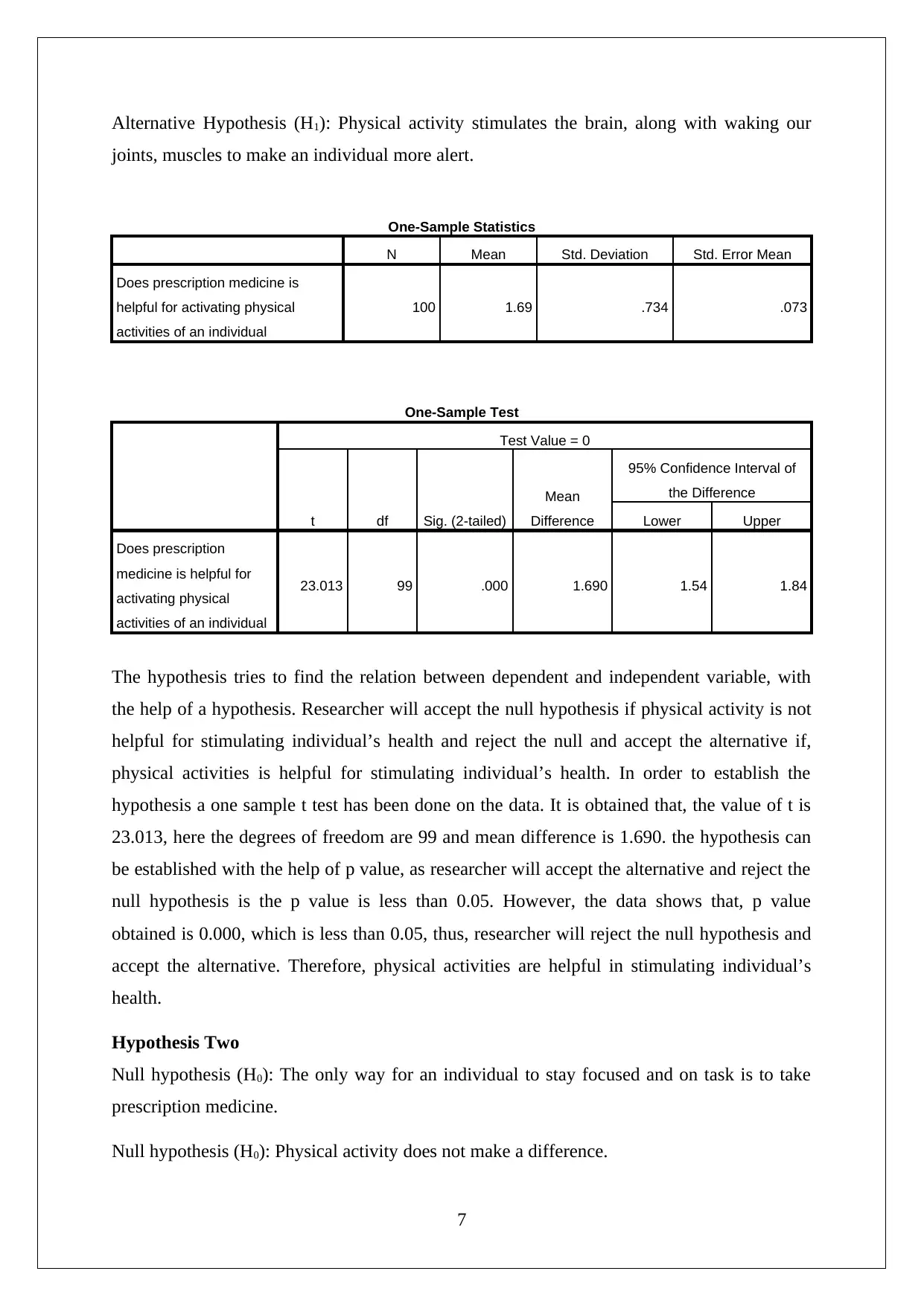
Alternative Hypothesis (H1): Physical activity stimulates the brain, along with waking our
joints, muscles to make an individual more alert.
One-Sample Statistics
N Mean Std. Deviation Std. Error Mean
Does prescription medicine is
helpful for activating physical
activities of an individual
100 1.69 .734 .073
One-Sample Test
Test Value = 0
t df Sig. (2-tailed)
Mean
Difference
95% Confidence Interval of
the Difference
Lower Upper
Does prescription
medicine is helpful for
activating physical
activities of an individual
23.013 99 .000 1.690 1.54 1.84
The hypothesis tries to find the relation between dependent and independent variable, with
the help of a hypothesis. Researcher will accept the null hypothesis if physical activity is not
helpful for stimulating individual’s health and reject the null and accept the alternative if,
physical activities is helpful for stimulating individual’s health. In order to establish the
hypothesis a one sample t test has been done on the data. It is obtained that, the value of t is
23.013, here the degrees of freedom are 99 and mean difference is 1.690. the hypothesis can
be established with the help of p value, as researcher will accept the alternative and reject the
null hypothesis is the p value is less than 0.05. However, the data shows that, p value
obtained is 0.000, which is less than 0.05, thus, researcher will reject the null hypothesis and
accept the alternative. Therefore, physical activities are helpful in stimulating individual’s
health.
Hypothesis Two
Null hypothesis (H0): The only way for an individual to stay focused and on task is to take
prescription medicine.
Null hypothesis (H0): Physical activity does not make a difference.
7
joints, muscles to make an individual more alert.
One-Sample Statistics
N Mean Std. Deviation Std. Error Mean
Does prescription medicine is
helpful for activating physical
activities of an individual
100 1.69 .734 .073
One-Sample Test
Test Value = 0
t df Sig. (2-tailed)
Mean
Difference
95% Confidence Interval of
the Difference
Lower Upper
Does prescription
medicine is helpful for
activating physical
activities of an individual
23.013 99 .000 1.690 1.54 1.84
The hypothesis tries to find the relation between dependent and independent variable, with
the help of a hypothesis. Researcher will accept the null hypothesis if physical activity is not
helpful for stimulating individual’s health and reject the null and accept the alternative if,
physical activities is helpful for stimulating individual’s health. In order to establish the
hypothesis a one sample t test has been done on the data. It is obtained that, the value of t is
23.013, here the degrees of freedom are 99 and mean difference is 1.690. the hypothesis can
be established with the help of p value, as researcher will accept the alternative and reject the
null hypothesis is the p value is less than 0.05. However, the data shows that, p value
obtained is 0.000, which is less than 0.05, thus, researcher will reject the null hypothesis and
accept the alternative. Therefore, physical activities are helpful in stimulating individual’s
health.
Hypothesis Two
Null hypothesis (H0): The only way for an individual to stay focused and on task is to take
prescription medicine.
Null hypothesis (H0): Physical activity does not make a difference.
7
Paraphrase This Document
Need a fresh take? Get an instant paraphrase of this document with our AI Paraphraser
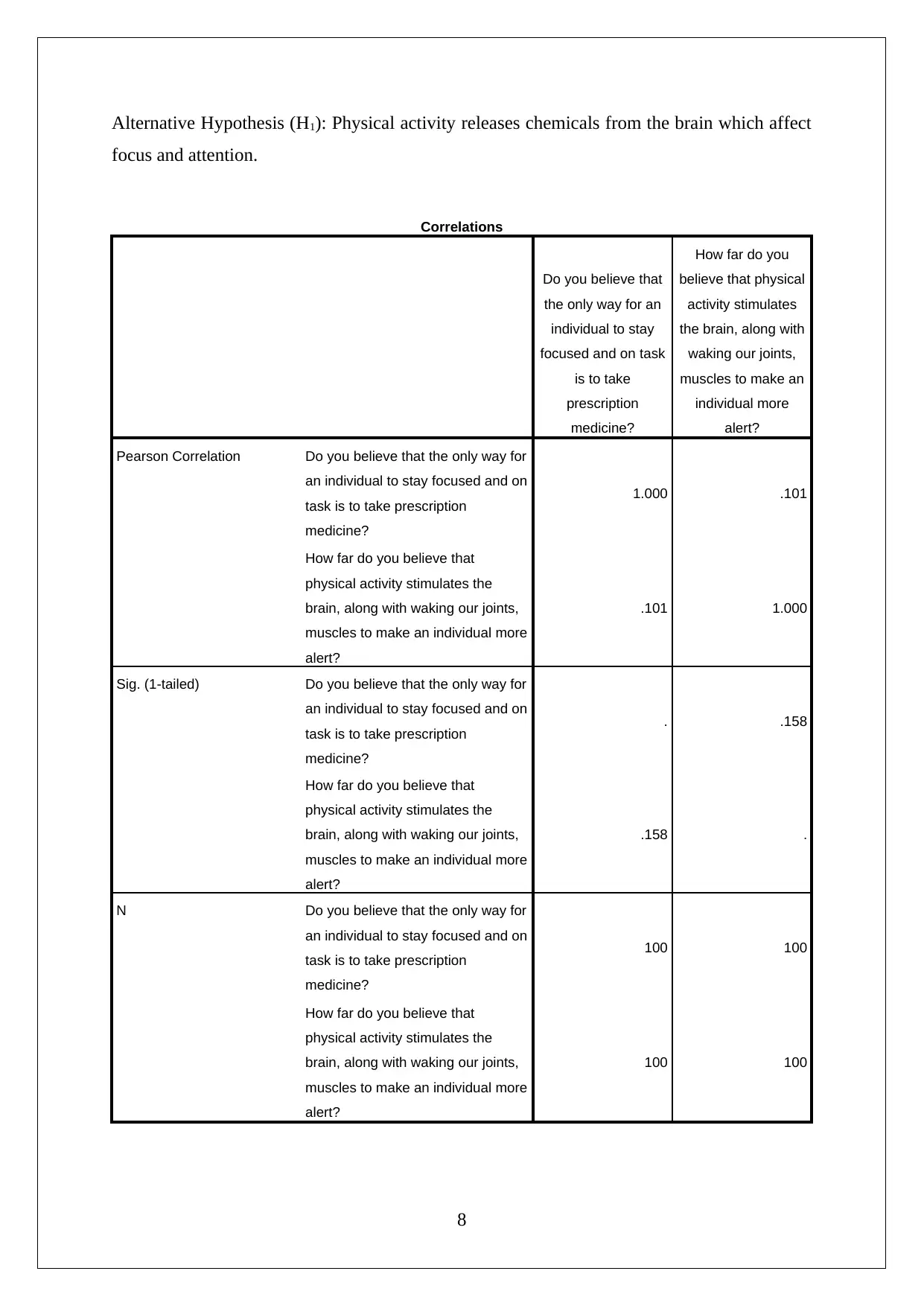
Alternative Hypothesis (H1): Physical activity releases chemicals from the brain which affect
focus and attention.
Correlations
Do you believe that
the only way for an
individual to stay
focused and on task
is to take
prescription
medicine?
How far do you
believe that physical
activity stimulates
the brain, along with
waking our joints,
muscles to make an
individual more
alert?
Pearson Correlation Do you believe that the only way for
an individual to stay focused and on
task is to take prescription
medicine?
1.000 .101
How far do you believe that
physical activity stimulates the
brain, along with waking our joints,
muscles to make an individual more
alert?
.101 1.000
Sig. (1-tailed) Do you believe that the only way for
an individual to stay focused and on
task is to take prescription
medicine?
. .158
How far do you believe that
physical activity stimulates the
brain, along with waking our joints,
muscles to make an individual more
alert?
.158 .
N Do you believe that the only way for
an individual to stay focused and on
task is to take prescription
medicine?
100 100
How far do you believe that
physical activity stimulates the
brain, along with waking our joints,
muscles to make an individual more
alert?
100 100
8
focus and attention.
Correlations
Do you believe that
the only way for an
individual to stay
focused and on task
is to take
prescription
medicine?
How far do you
believe that physical
activity stimulates
the brain, along with
waking our joints,
muscles to make an
individual more
alert?
Pearson Correlation Do you believe that the only way for
an individual to stay focused and on
task is to take prescription
medicine?
1.000 .101
How far do you believe that
physical activity stimulates the
brain, along with waking our joints,
muscles to make an individual more
alert?
.101 1.000
Sig. (1-tailed) Do you believe that the only way for
an individual to stay focused and on
task is to take prescription
medicine?
. .158
How far do you believe that
physical activity stimulates the
brain, along with waking our joints,
muscles to make an individual more
alert?
.158 .
N Do you believe that the only way for
an individual to stay focused and on
task is to take prescription
medicine?
100 100
How far do you believe that
physical activity stimulates the
brain, along with waking our joints,
muscles to make an individual more
alert?
100 100
8
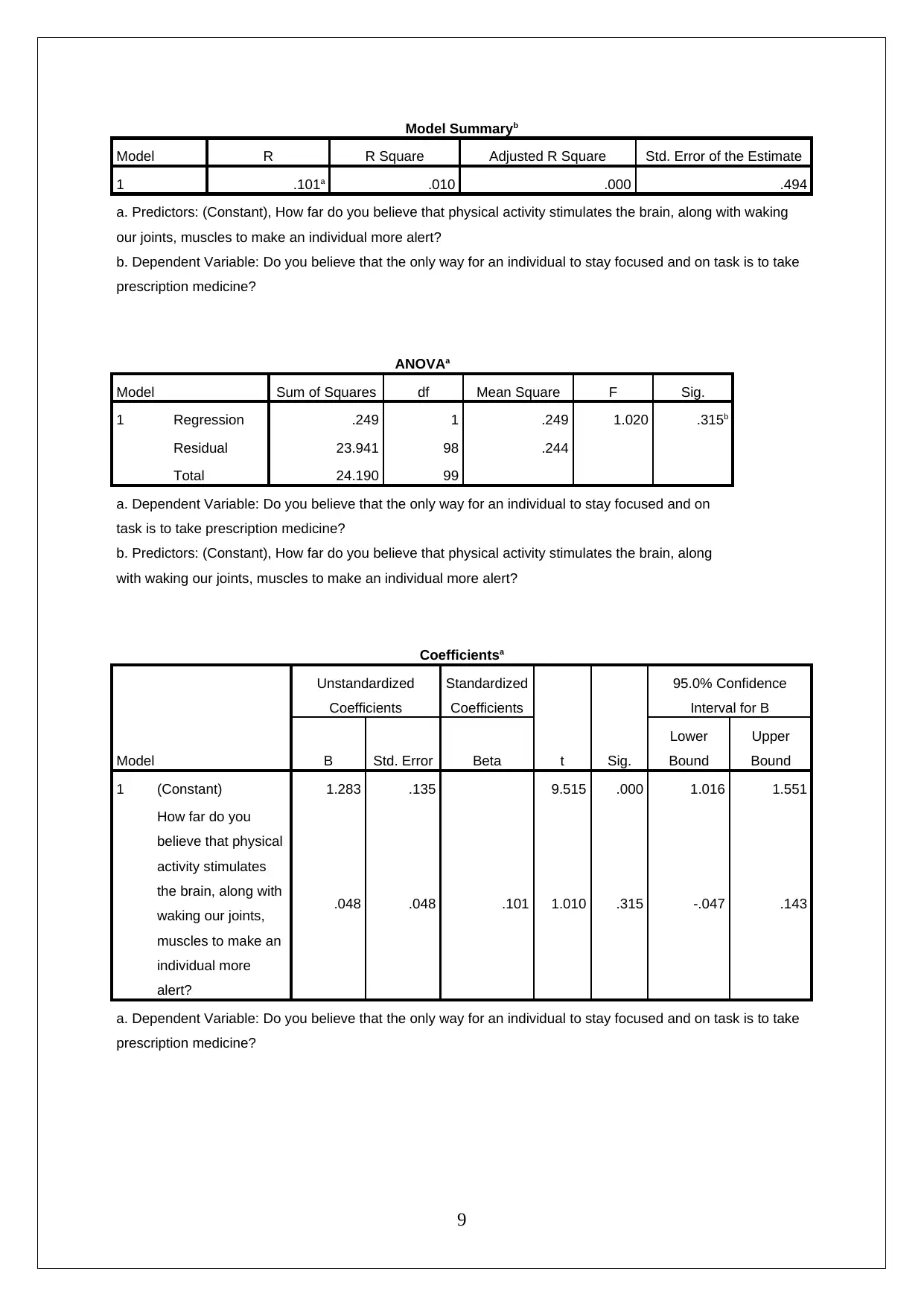
Model Summaryb
Model R R Square Adjusted R Square Std. Error of the Estimate
1 .101a .010 .000 .494
a. Predictors: (Constant), How far do you believe that physical activity stimulates the brain, along with waking
our joints, muscles to make an individual more alert?
b. Dependent Variable: Do you believe that the only way for an individual to stay focused and on task is to take
prescription medicine?
ANOVAa
Model Sum of Squares df Mean Square F Sig.
1 Regression .249 1 .249 1.020 .315b
Residual 23.941 98 .244
Total 24.190 99
a. Dependent Variable: Do you believe that the only way for an individual to stay focused and on
task is to take prescription medicine?
b. Predictors: (Constant), How far do you believe that physical activity stimulates the brain, along
with waking our joints, muscles to make an individual more alert?
Coefficientsa
Model
Unstandardized
Coefficients
Standardized
Coefficients
t Sig.
95.0% Confidence
Interval for B
B Std. Error Beta
Lower
Bound
Upper
Bound
1 (Constant) 1.283 .135 9.515 .000 1.016 1.551
How far do you
believe that physical
activity stimulates
the brain, along with
waking our joints,
muscles to make an
individual more
alert?
.048 .048 .101 1.010 .315 -.047 .143
a. Dependent Variable: Do you believe that the only way for an individual to stay focused and on task is to take
prescription medicine?
9
Model R R Square Adjusted R Square Std. Error of the Estimate
1 .101a .010 .000 .494
a. Predictors: (Constant), How far do you believe that physical activity stimulates the brain, along with waking
our joints, muscles to make an individual more alert?
b. Dependent Variable: Do you believe that the only way for an individual to stay focused and on task is to take
prescription medicine?
ANOVAa
Model Sum of Squares df Mean Square F Sig.
1 Regression .249 1 .249 1.020 .315b
Residual 23.941 98 .244
Total 24.190 99
a. Dependent Variable: Do you believe that the only way for an individual to stay focused and on
task is to take prescription medicine?
b. Predictors: (Constant), How far do you believe that physical activity stimulates the brain, along
with waking our joints, muscles to make an individual more alert?
Coefficientsa
Model
Unstandardized
Coefficients
Standardized
Coefficients
t Sig.
95.0% Confidence
Interval for B
B Std. Error Beta
Lower
Bound
Upper
Bound
1 (Constant) 1.283 .135 9.515 .000 1.016 1.551
How far do you
believe that physical
activity stimulates
the brain, along with
waking our joints,
muscles to make an
individual more
alert?
.048 .048 .101 1.010 .315 -.047 .143
a. Dependent Variable: Do you believe that the only way for an individual to stay focused and on task is to take
prescription medicine?
9
⊘ This is a preview!⊘
Do you want full access?
Subscribe today to unlock all pages.

Trusted by 1+ million students worldwide
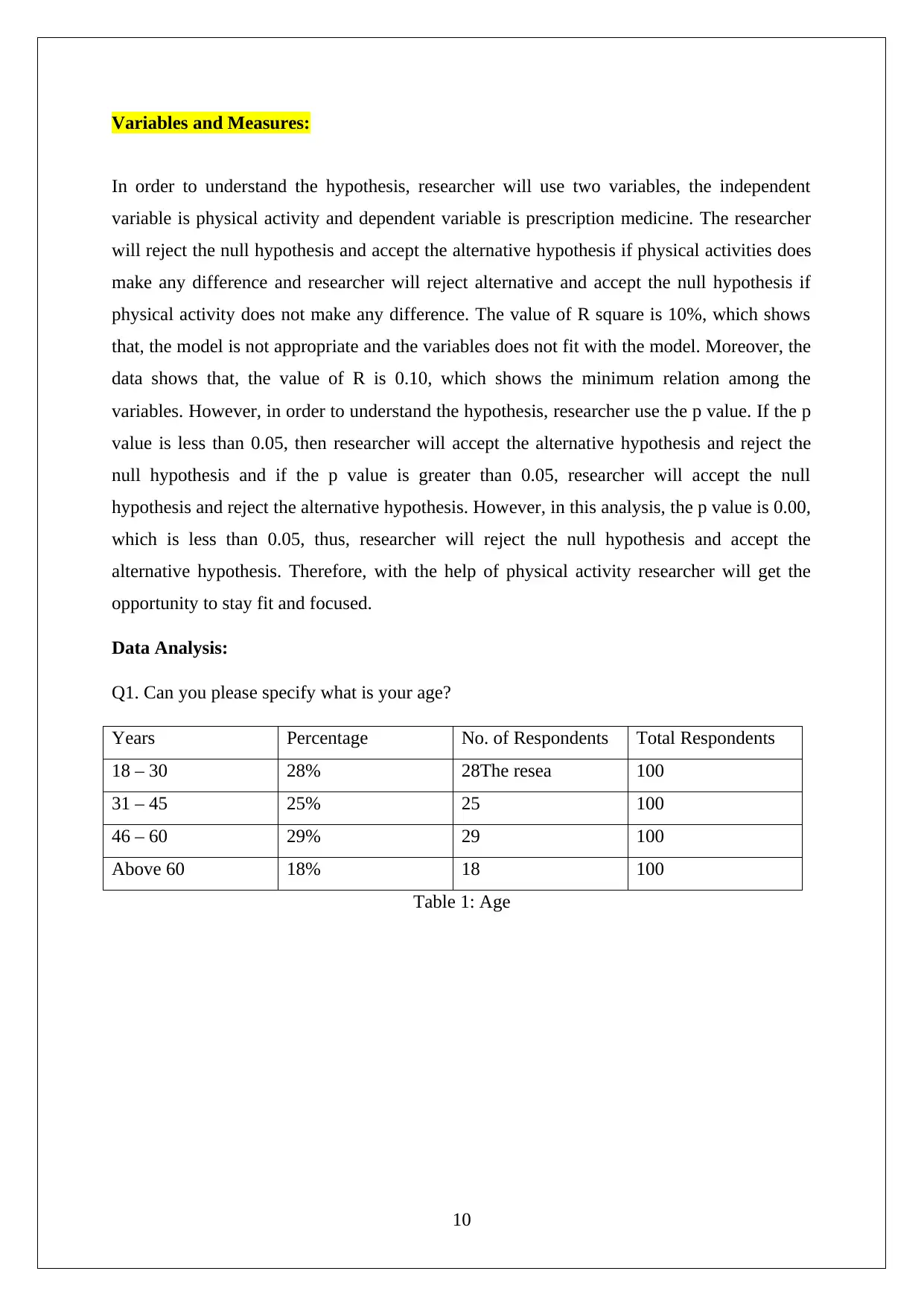
Variables and Measures:
In order to understand the hypothesis, researcher will use two variables, the independent
variable is physical activity and dependent variable is prescription medicine. The researcher
will reject the null hypothesis and accept the alternative hypothesis if physical activities does
make any difference and researcher will reject alternative and accept the null hypothesis if
physical activity does not make any difference. The value of R square is 10%, which shows
that, the model is not appropriate and the variables does not fit with the model. Moreover, the
data shows that, the value of R is 0.10, which shows the minimum relation among the
variables. However, in order to understand the hypothesis, researcher use the p value. If the p
value is less than 0.05, then researcher will accept the alternative hypothesis and reject the
null hypothesis and if the p value is greater than 0.05, researcher will accept the null
hypothesis and reject the alternative hypothesis. However, in this analysis, the p value is 0.00,
which is less than 0.05, thus, researcher will reject the null hypothesis and accept the
alternative hypothesis. Therefore, with the help of physical activity researcher will get the
opportunity to stay fit and focused.
Data Analysis:
Q1. Can you please specify what is your age?
Years Percentage No. of Respondents Total Respondents
18 – 30 28% 28The resea 100
31 – 45 25% 25 100
46 – 60 29% 29 100
Above 60 18% 18 100
Table 1: Age
10
In order to understand the hypothesis, researcher will use two variables, the independent
variable is physical activity and dependent variable is prescription medicine. The researcher
will reject the null hypothesis and accept the alternative hypothesis if physical activities does
make any difference and researcher will reject alternative and accept the null hypothesis if
physical activity does not make any difference. The value of R square is 10%, which shows
that, the model is not appropriate and the variables does not fit with the model. Moreover, the
data shows that, the value of R is 0.10, which shows the minimum relation among the
variables. However, in order to understand the hypothesis, researcher use the p value. If the p
value is less than 0.05, then researcher will accept the alternative hypothesis and reject the
null hypothesis and if the p value is greater than 0.05, researcher will accept the null
hypothesis and reject the alternative hypothesis. However, in this analysis, the p value is 0.00,
which is less than 0.05, thus, researcher will reject the null hypothesis and accept the
alternative hypothesis. Therefore, with the help of physical activity researcher will get the
opportunity to stay fit and focused.
Data Analysis:
Q1. Can you please specify what is your age?
Years Percentage No. of Respondents Total Respondents
18 – 30 28% 28The resea 100
31 – 45 25% 25 100
46 – 60 29% 29 100
Above 60 18% 18 100
Table 1: Age
10
Paraphrase This Document
Need a fresh take? Get an instant paraphrase of this document with our AI Paraphraser
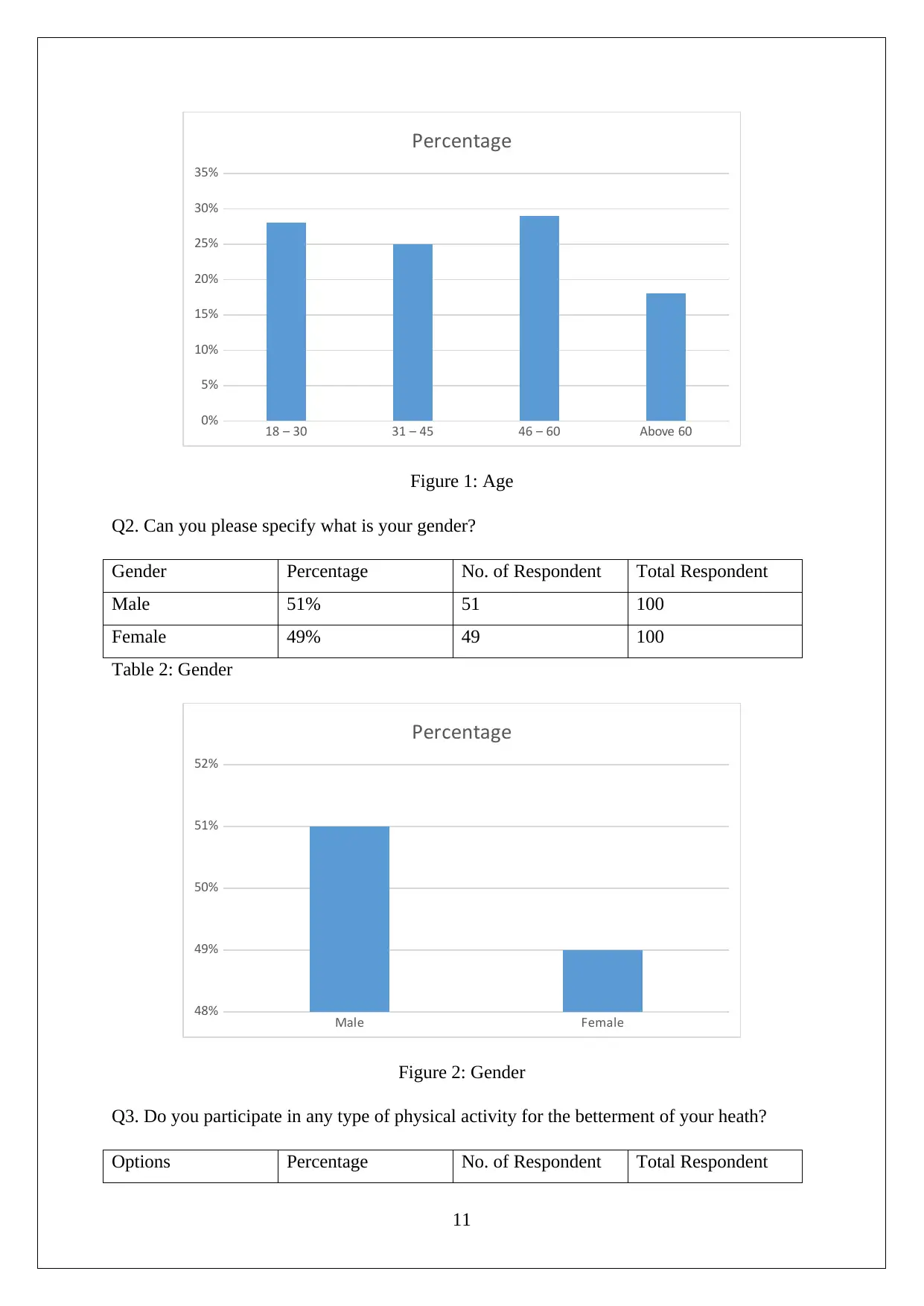
18 – 30 31 – 45 46 – 60 Above 60
0%
5%
10%
15%
20%
25%
30%
35%
Percentage
Figure 1: Age
Q2. Can you please specify what is your gender?
Gender Percentage No. of Respondent Total Respondent
Male 51% 51 100
Female 49% 49 100
Table 2: Gender
Male Female
48%
49%
50%
51%
52%
Percentage
Figure 2: Gender
Q3. Do you participate in any type of physical activity for the betterment of your heath?
Options Percentage No. of Respondent Total Respondent
11
0%
5%
10%
15%
20%
25%
30%
35%
Percentage
Figure 1: Age
Q2. Can you please specify what is your gender?
Gender Percentage No. of Respondent Total Respondent
Male 51% 51 100
Female 49% 49 100
Table 2: Gender
Male Female
48%
49%
50%
51%
52%
Percentage
Figure 2: Gender
Q3. Do you participate in any type of physical activity for the betterment of your heath?
Options Percentage No. of Respondent Total Respondent
11
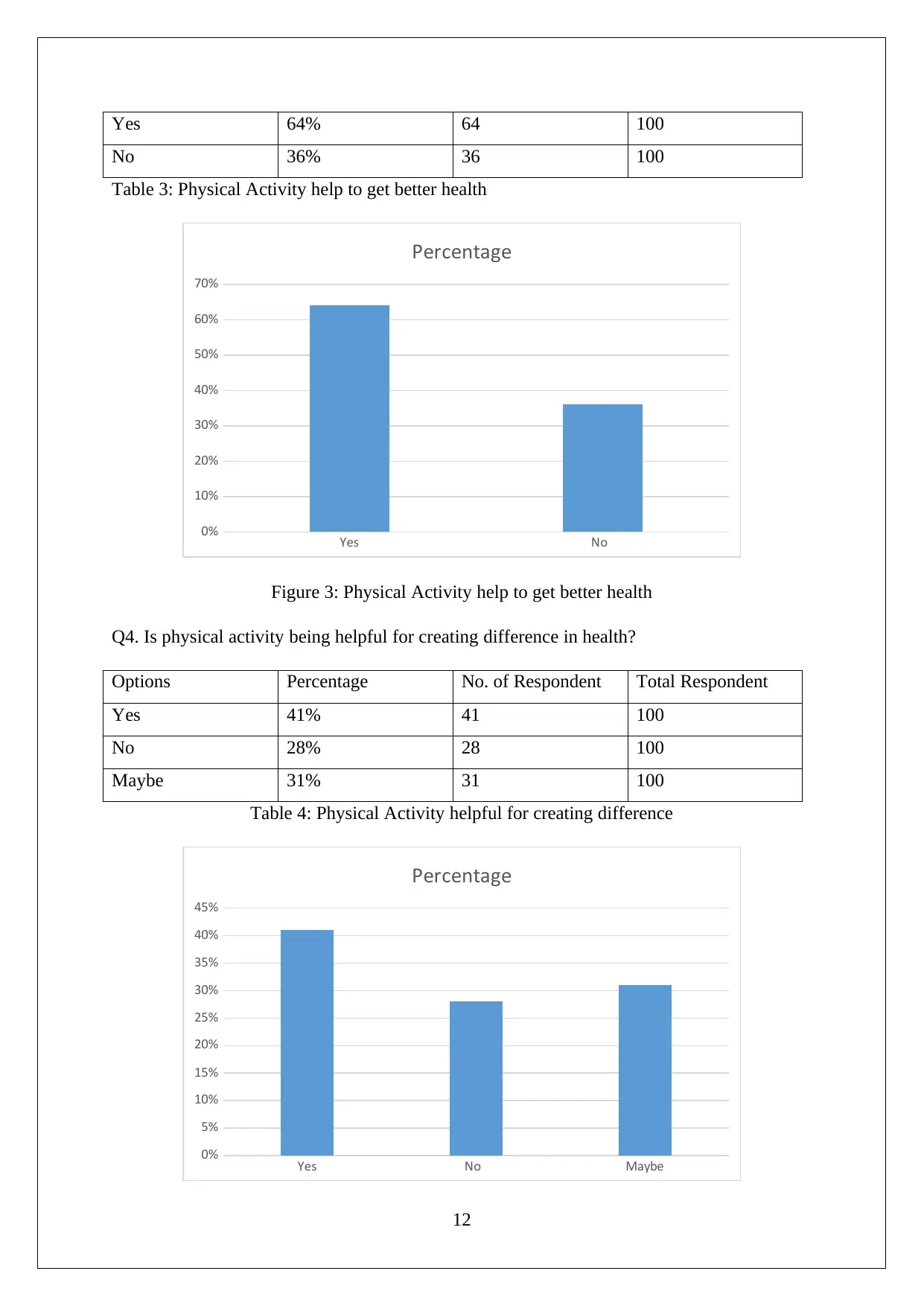
Yes 64% 64 100
No 36% 36 100
Table 3: Physical Activity help to get better health
Yes No
0%
10%
20%
30%
40%
50%
60%
70%
Percentage
Figure 3: Physical Activity help to get better health
Q4. Is physical activity being helpful for creating difference in health?
Options Percentage No. of Respondent Total Respondent
Yes 41% 41 100
No 28% 28 100
Maybe 31% 31 100
Table 4: Physical Activity helpful for creating difference
Yes No Maybe
0%
5%
10%
15%
20%
25%
30%
35%
40%
45%
Percentage
12
No 36% 36 100
Table 3: Physical Activity help to get better health
Yes No
0%
10%
20%
30%
40%
50%
60%
70%
Percentage
Figure 3: Physical Activity help to get better health
Q4. Is physical activity being helpful for creating difference in health?
Options Percentage No. of Respondent Total Respondent
Yes 41% 41 100
No 28% 28 100
Maybe 31% 31 100
Table 4: Physical Activity helpful for creating difference
Yes No Maybe
0%
5%
10%
15%
20%
25%
30%
35%
40%
45%
Percentage
12
⊘ This is a preview!⊘
Do you want full access?
Subscribe today to unlock all pages.

Trusted by 1+ million students worldwide
1 out of 18
Related Documents
Your All-in-One AI-Powered Toolkit for Academic Success.
+13062052269
info@desklib.com
Available 24*7 on WhatsApp / Email
![[object Object]](/_next/static/media/star-bottom.7253800d.svg)
Unlock your academic potential
Copyright © 2020–2025 A2Z Services. All Rights Reserved. Developed and managed by ZUCOL.





